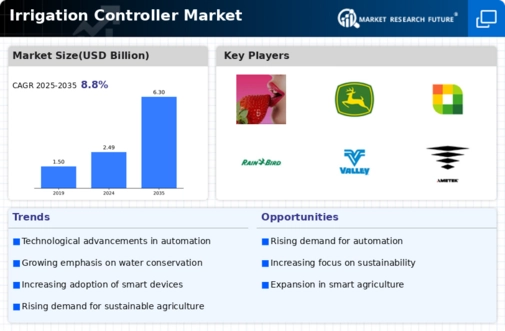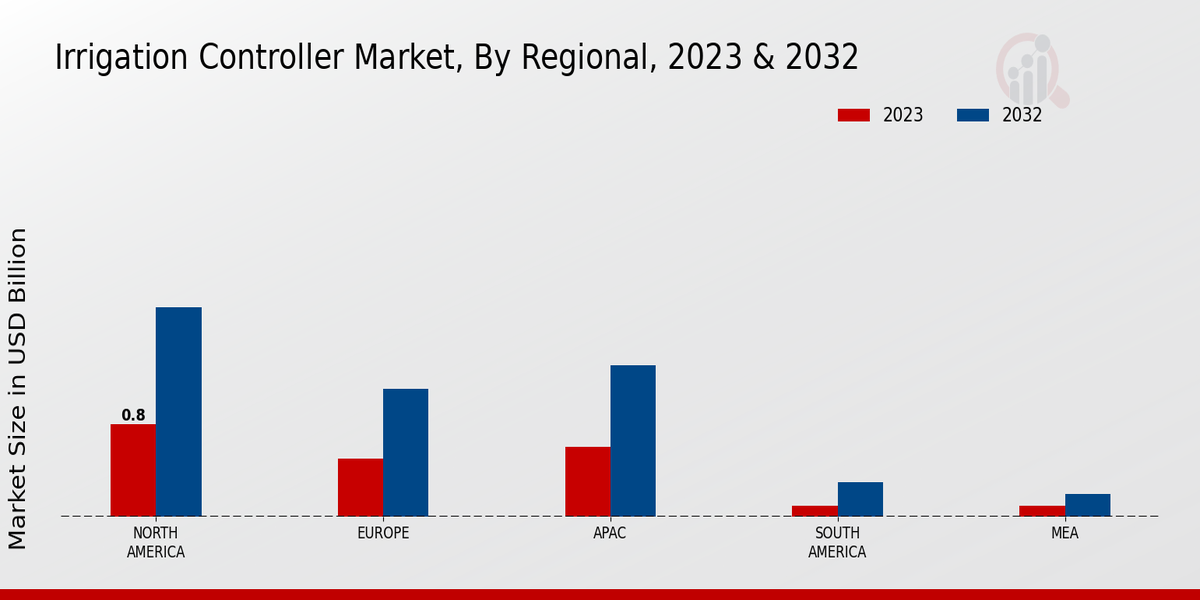Rising Water Scarcity
The increasing prevalence of water scarcity globally is driving the demand for efficient irrigation solutions within the Global Irrigation Controller Market Industry. As freshwater resources become more limited, farmers are compelled to adopt technologies that optimize water usage. This trend is particularly evident in regions facing severe drought conditions, where traditional irrigation methods are insufficient. The market is anticipated to grow at a CAGR of 8.8% from 2025 to 2035, highlighting the urgency for innovative irrigation controllers that can conserve water while maintaining crop productivity. The urgency of addressing water scarcity is likely to propel further investment in advanced irrigation technologies.
Market Growth Projections
The Global Irrigation Controller Market Industry is poised for substantial growth, with projections indicating a market size of 2.49 USD Billion in 2024 and an anticipated increase to 6.3 USD Billion by 2035. This growth trajectory suggests a robust demand for innovative irrigation solutions, driven by factors such as technological advancements, government regulations, and the need for sustainable practices. The market is expected to experience a CAGR of 8.8% from 2025 to 2035, reflecting the increasing adoption of efficient irrigation controllers across various agricultural sectors. These projections underscore the importance of continued investment in research and development to meet the evolving needs of the agricultural industry.
Technological Advancements
The Global Irrigation Controller Market Industry is experiencing a surge in technological advancements, particularly with the integration of smart technologies. These innovations include soil moisture sensors, weather-based controllers, and mobile applications that allow for remote management. Such technologies not only enhance water efficiency but also reduce operational costs for farmers. As a result, the market is projected to reach 2.49 USD Billion in 2024, reflecting the growing demand for efficient irrigation solutions. The adoption of these advanced systems is likely to drive significant growth, as they offer precise control over irrigation schedules, thereby optimizing water usage and improving crop yields.
Government Initiatives and Regulations
Government initiatives aimed at promoting sustainable agriculture practices are playing a crucial role in the Global Irrigation Controller Market Industry. Various countries are implementing regulations that encourage the adoption of water-efficient irrigation systems. For instance, subsidies and financial incentives are being offered to farmers who invest in modern irrigation technologies. These efforts are expected to contribute to the market's growth, with projections indicating an increase to 6.3 USD Billion by 2035. Such policies not only support environmental sustainability but also enhance food security by ensuring efficient water management in agricultural practices.
Market Penetration of Smart Agriculture
The penetration of smart agriculture practices is significantly impacting the Global Irrigation Controller Market Industry. Farmers are increasingly utilizing data analytics, IoT devices, and automation to enhance their irrigation systems. This trend is indicative of a broader movement towards precision agriculture, where data-driven decisions lead to improved resource management. As the market evolves, the integration of these technologies is expected to drive growth, with projections indicating a market size of 2.49 USD Billion in 2024. The potential for smart irrigation solutions to optimize water usage and increase crop yields is likely to attract further investment in this sector.
Growing Awareness of Sustainable Practices
There is a growing awareness among farmers and agricultural stakeholders regarding the importance of sustainable practices, which is positively influencing the Global Irrigation Controller Market Industry. As consumers increasingly demand sustainably sourced products, farmers are adopting irrigation controllers that minimize water waste and enhance crop health. This shift towards sustainability is supported by educational programs and resources provided by agricultural organizations. The market's growth trajectory suggests that by 2035, it could reach 6.3 USD Billion, driven by the collective efforts of stakeholders to implement environmentally friendly practices in agriculture.












